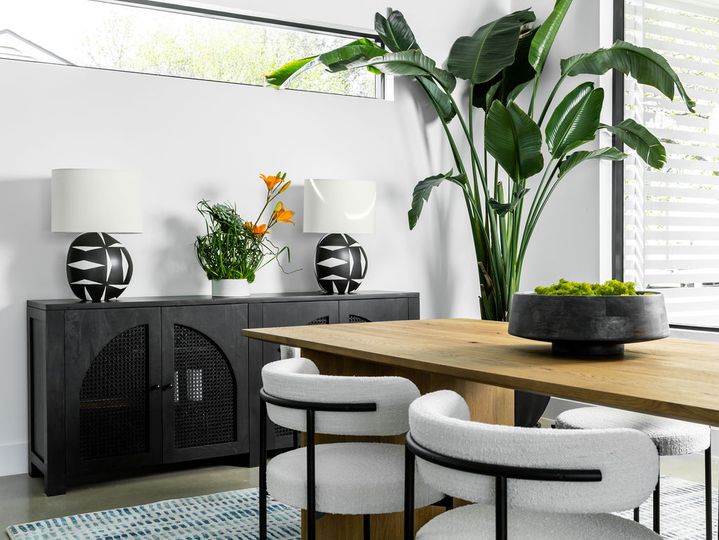5 Landscaping Mistakes Homeowners Make (and How to Avoid Them)

Turning your vision of a beautiful outdoor space into reality can be incredibly rewarding. However, many homeowners fall into common traps that can leave their landscapes looking less than stellar. Here, we’ll explore five of the most frequent mistakes and provide tips to navigate them, ensuring your yard thrives.
Planting Without a Plan: How to Choose the Right Plants for Your Yard
The Mistake: Impulse buys at the nursery or succumbing to trendy fads can lead to a mishmash of plants that clash aesthetically and struggle to thrive in your environment.
The Solution: Before diving headfirst, consider the following:
- Sun Exposure: Map your yard’s sunlight patterns throughout the day. Some plants require full sun, while others prefer shade. Mismatched sun needs can lead to stunted growth or even plant death.
- Soil Conditions: Different plants require different soil types (clay, sandy, etc.). Conducting a simple soil test will reveal your soil’s composition, allowing you to choose plants that flourish in those conditions.
- Mature Size: Many homeowners underestimate how large plants can become. Imagine that cute little sapling ten years down the line. Will it overpower your house or crowd out other plantings? Research mature plant sizes and space them accordingly.
- Climate and Hardiness Zone: Ensure your chosen plants can withstand your local climate. The USDA Plant Hardiness Zone Map divides the country into zones based on average winter temperatures. Selecting plants suited to your zone guarantees their survival through the colder months.
- Water Needs: Some plants are drought-tolerant, while others require frequent watering. Consider your watering habits and choose plants with compatible needs.
Pro Tip: Don’t be afraid to seek professional help! Consider consulting with a local landscape design service in Dallas. They can assess your yard’s unique characteristics and create a customized plan featuring plants that thrive in your environment.
Size Matters: Avoiding Plant Placement Pitfalls
The Mistake: Planting trees or shrubs too close to your house, foundation, or walkways can lead to future problems.
The Solution:
- Root Systems: Research the root systems of your chosen plants. Shallow-rooted plants can be placed closer to structures, while deep-rooted varieties require ample space to avoid foundation damage or cracked walkways.
- Overhead Clearance: Consider how tall plants will grow and allow sufficient clearance above walkways and driveways to avoid future obstructions. Think about power lines and mailboxes too!
- Spacing for Growth: Leave enough space between plants for them to reach their mature size without overcrowding. Dense planting can inhibit air circulation, promote disease, and make maintenance difficult.

Overlooking the Basics: Essential Preparation Before You Dig In
The Mistake: Skipping crucial preparation steps can lead to frustration and wasted effort down the line.
The Solution:
- Call Before You Dig: Before digging anywhere in your yard, contact your local utility companies to mark any underground lines to avoid accidental damage.
- Soil Amending: Your existing soil may not be ideal for your chosen plants. Amending your soil with compost, organic matter, or sand (depending on your soil test results) can significantly improve drainage and nutrient content, fostering healthier plant growth.
- Weed Control: Deal with existing weeds before planting. Persistent weeds can quickly choke out your new plants and steal valuable resources. Consider using natural weed control methods like hand-pulling or smothering with cardboard before planting.
Maintenance Mishaps: Keeping Your Landscape Looking Lush
The Mistake: Neglecting regular maintenance can quickly turn your beautiful landscape into an overgrown mess.
The Solution:
- Watering: Watering needs vary by plant type, season, and weather conditions. Learn the specific watering requirements of your plants and adjust your routine accordingly.
- Pruning: Regular pruning promotes healthy growth, encourages flowering, and maintains the desired shape of your plants.
- Mulching: Applying a layer of mulch around your plants helps retain moisture, suppress weeds, and regulate soil temperature.
- Fertilization: Regular fertilization provides your plants with essential nutrients needed for healthy growth and vibrant flowering.
DIY Disasters: When to Call In a Professional Landscaper
-
The Mistake: Tackling a project beyond your skillset or time constraints can lead to a disappointing outcome.
The Solution:
Know Your Limits: Be honest with yourself about your DIY capabilities. Extensive projects, major hardscaping installations, or complex drainage solutions are best left to professionals like those found at top interior design companies.
Time Commitment: Maintaining a healthy landscape requires regular care. Consider your available time and energy before embarking on a project.









